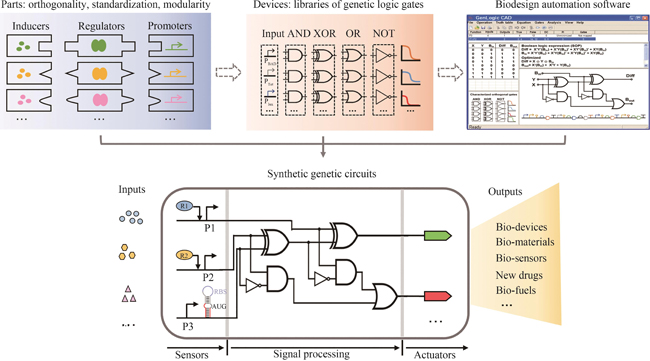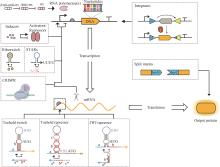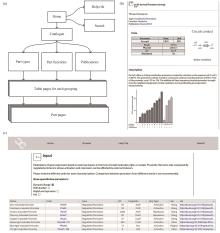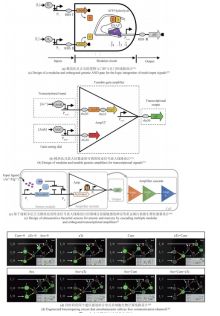|
||
|
Synthetic genetic circuit engineering: principles, advances and prospects
Synthetic Biology Journal
2025, 6 (1):
45-64.
DOI: 10.12211/2096-8280.2023-096
Synthetic genetic circuits are engineered gene networks comprised of redesigned genetic parts for interacting to perform customized functions in cells. With the rapid development of synthetic biology, synthetic genetic circuits have shown significant application potentials in many fields such as biomanufacturing, healthcare and environmental monitoring. However, the efforts to scale up genetic circuits are hindered by the limited number of orthogonal parts, the difficulty of functionally composing large-scale circuits, and the poor predictability of circuit behaviors. A longstanding goal of synthetic biology research is to engineer complex synthetic biological circuits, using modular genetic parts, as we do with electronic circuits. Synthetic biologists have developed various genetic toolboxes and functional assembly methods over the past few decades. Here we present an overview of the latest advances, challenges, and future prospects in genetic circuit engineering from four aspects corresponding to the four key engineering principles for circuit design, i.e. orthogonality, standardization, modularity, and automation. Firstly, the design and construction of orthogonal genetic part libraries are discussed in both prokaryotes and eukaryotes at the levels of DNA replication, transcription, and translation, respectively. Standardized characterization methods and the design of modular genetic parts are subsequently summarized. Furthermore, progress in developing modular genetic circuits are presented, providing new concepts and ways for engineering increasingly large and complex circuits. Finally, how to achieve automated design and building of genetic circuits are addressed from the advances in software, hardware and artificial intelligence, respectively, with an aim to replacing the presently time-consuming manual trial-and-error mode with the iterative "design-build-test-learn" cycle for improved efficiency and predictability of circuit design. The integration of these fundamental principles and the latest advances in information technology such as artificial intelligence and lab automation will accelerate the paradigm shift in genetic circuit engineering and synthetic biology research, making it feasible for designing synthetic lives to meet various customized needs.

Fig. 4
An automated "design-build-test-learn" cycle for genetic circuit engineering.
(Automated instrumentation in biofoundries is adapted from reference [
Extracts from the Article
目前大多数基因线路都是由研究人员手动设计并不断地进行试错,需要消耗大量的时间和精力且容易出现错误。结合线路设计软件与高通量模块化的实验室设备,可快速完成复杂基因线路的“设计-构建-测试-学习”这一闭环(图4)。
Other Images/Table from this Article
|



